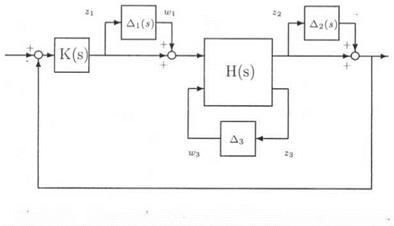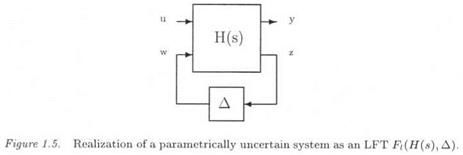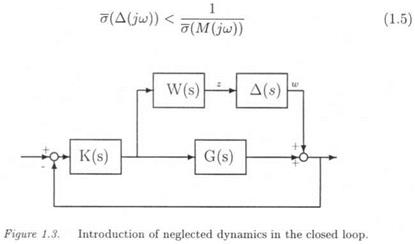COMPUTATION OF THE ROBUSTNESS
MARGIN
In the context of a robust stability problem, l/fi(M(jw)) represents the size of the smallest parametric uncertainty S, which brings one closed loop pole on the imaginary axis at ±ju. The robust stability margin kmax is obtained by computing the s. s.v. along the imaginary axis:
The principle is thus to detect the crossing of one of the closed loop poles through the imaginary axis. ктах corresponds to the size of the smallest parametric uncertainty 8, which brings one closed loop pole on the imaginary axis.
Remark: several reasons exist for handling the, v..v. к n(M(ju)) rather than its inverse the multiloop stability margin (m. s.m.).
As a first point, the s. s.v. can not take an infinite value, since
the nominal closed loop is asymptotically stable, whereas the m. s.m. may be infinite (if no structured model perturbation exists, which destabilizes the closed loop). On the other hand, the s. s.v. can be considered as an extension of classical algebraic notions, namely the spectral radius and the maximal singular value of a matrix (i. e. its spectral norm – see below).
2.2 THE GENERAL CASE
The problem of extending the approach of subsection 2.1 to the case of neglected dynamics seems a priori more complex, since Д is now a dynamic transfer matrix instead of a simple gain matrix. Nevertheless, assume that a complex matrix Д0 was found, which satisfies det(I – M(ju>)A°) = 0 at frequency u>. It suffices then to find a transfer matrix A(s) with A(ju}) = Д0. When applying A(s) to the interconnection structure, a closed loop pole is obtained on the imaginary axis at ±juj.











 The issue is first to realize the parametrically uncertain plant model as an LFT Fi(H(s), Д3) (see subsection 1.4). The control law is then connected with the plant and the neglected dynamics are finally added at various locations of the closed loop. The standard interconnection structure M{s) — A(s) is obtained, by noting that M(s) is the transfer matrix seen by the structured model perturbation A(s).
The issue is first to realize the parametrically uncertain plant model as an LFT Fi(H(s), Д3) (see subsection 1.4). The control law is then connected with the plant and the neglected dynamics are finally added at various locations of the closed loop. The standard interconnection structure M{s) — A(s) is obtained, by noting that M(s) is the transfer matrix seen by the structured model perturbation A(s).



